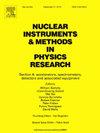为稀有放射性同位素环开发基于微通道板的低能量损耗位置敏感探测器
IF 1.5
3区 物理与天体物理
Q3 INSTRUMENTS & INSTRUMENTATION
Nuclear Instruments & Methods in Physics Research Section A-accelerators Spectrometers Detectors and Associated Equipment
Pub Date : 2024-10-16
DOI:10.1016/j.nima.2024.169980
引用次数: 0
摘要
为日本理化学研究所的稀有放射性同位素环开发了一种位置敏感微通道板式探测器。它利用从转换箔发射并偏转 90° 的二次电子来产生位置信号。设计方面的限制包括:在高真空环境中运行、大面积覆盖环接受范围以及低光束相互作用以减少能量损失。它必须达到足以测量环内色散的精度,并为调整注入进行位置诊断。减少次级电子的飞行时间是提高分辨率的主要因素,因为这可以减少其最终高斯扩散。具体做法是压缩探测器的几何结构并提高加速电势。通过将静电栅线间距从 2 毫米减小到 1 毫米,电场均匀性也得到了改善。对α源进行了离线测试,对 200 MeV/u 84Kr 射束进行了在线测试,最终达到了 σ = 1.3 毫米的平均位置分辨率。这足以在存储环中进行光束诊断。本文章由计算机程序翻译,如有差异,请以英文原文为准。
Development of a low energy loss micro-channel plate based position-sensitive detector for the Rare Radio-Isotope Ring
A position-sensitive micro-channel plate type detector has been developed for use in the Rare Radio-Isotope Ring at RIKEN, Japan. It uses secondary electrons emitted from a conversion foil and deflected at 90° to create a position signal. Design constraints included operation in a high-vacuum, a large area to cover the ring acceptance and low beam interaction to reduce energy loss. It must achieve a precision sufficient to measure the in-ring dispersion and perform position diagnostics for tuning the injection. Reducing the time-of-flight of secondary electrons was principal in improving resolution as it reduces their final Gaussian spread. This was implemented by compacting the geometry of the detector and raising the acceleration potential. Electric field homogeneity was also improved by decreasing the electrostatic grid wire pitch from 2 mm to 1 mm. Offline tests with alpha sources and online tests with a 200 MeV/u 84Kr beam were conducted, reaching a final average position resolution of = 1.3 mm. This is sufficient for conducting beam diagnostics in the storage ring.
求助全文
通过发布文献求助,成功后即可免费获取论文全文。
去求助
来源期刊
CiteScore
3.20
自引率
21.40%
发文量
787
审稿时长
1 months
期刊介绍:
Section A of Nuclear Instruments and Methods in Physics Research publishes papers on design, manufacturing and performance of scientific instruments with an emphasis on large scale facilities. This includes the development of particle accelerators, ion sources, beam transport systems and target arrangements as well as the use of secondary phenomena such as synchrotron radiation and free electron lasers. It also includes all types of instrumentation for the detection and spectrometry of radiations from high energy processes and nuclear decays, as well as instrumentation for experiments at nuclear reactors. Specialized electronics for nuclear and other types of spectrometry as well as computerization of measurements and control systems in this area also find their place in the A section.
Theoretical as well as experimental papers are accepted.

 求助内容:
求助内容: 应助结果提醒方式:
应助结果提醒方式:


